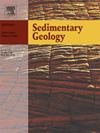江苏徐州寒武纪Milankovitch旋回和SPICE事件约束下的天文时间尺度和地层划分
IF 2.9
2区 地球科学
Q1 GEOLOGY
引用次数: 0
摘要
华北地区寒武系内部年龄缺乏高精度的年龄约束,一直影响着世界范围内寒武系地层的研究与比较。利用徐州地区寒武系地层磁化率资料,确定了沉积地层中的米兰科维奇旋回。利用稳定的碳同位素偏移曲线,研究区下伏龙系显示出一个阶梯正碳同位素偏移(SPICE)事件,持续时间为~ 1.6-1.8 Myr,峰值年龄限制为494.6±2.9 Ma。利用满头组(第4期)底部海绿石颗粒原位RbSr测年,确定其地层年龄约为513 Ma。通过将确定的405-kyr校准时间序列锚定到这两个年龄,构建了一个相对高分辨率的天文时间尺度。结果表明,华北徐州地区寒武系第4期至第10期早期跨度为512.30±2.9 Ma ~ 490.03±2.9 Ma,历时22.27±0.2 Myr。其中,满头组(二系—妙岭系)的基底年龄;第4期至鼓期早期),张夏组(苗岭期至芙蓉期);鼓面期早期至牌边期中期)和芙蓉系朝米店组;排边中期至早期10)分别为512.30±2.9 Ma、504.00±2.9 Ma和495.74±2.9 Ma,持续时间为8.30±0.2 Myr、8.26±0.2 Myr和5.71±0.2 Myr。这一系列研究不仅规范了徐州地区岩石地层单元的划分,而且为探讨寒武纪气候-生物群-环境-生态演化提供了精确的年代学依据。本文章由计算机程序翻译,如有差异,请以英文原文为准。
Astronomical time scale and stratigraphic division constrained by the Milankovitch cycles and SPICE event in the Cambrian of the Xuzhou, Jiangsu Province
The lack of high-precision age constraints for the internal age of the Cambrian in North China has always affected the research and comparison of Cambrian strata worldwide. This study, using magnetic susceptibility data from the Cambrian strata of the Xuzhou area, identifies Milankovitch cycles within the sedimentary strata. By utilizing stable carbon isotope excursion curves, the lower Furongian in the study area was discerned to exhibit a Steptoean positive carbon isotope excursion (SPICE) event, lasting ∼1.6–1.8 Myr, with a peak age constrained to 494.6 ± 2.9 Ma. Using in situ Rb![]() Sr dating from glauconite grains in the base of the Mantou Formation (Stage 4), the stratigraphic age was constrained to about 513 Ma. By anchoring the identified 405-kyr calibration time series to these two ages, a relatively high-resolution astronomical time scale was constructed. The results indicate that the Cambrian Stage 4 to early Stage 10 in the Xuzhou area of North China spans from 512.30 ± 2.9 Ma to 490.03 ± 2.9 Ma, with a duration of 22.27 ± 0.2 Myr. Specifically, the basal ages of the Mantou Formation (Series 2 to Miaolingian Series; Stage 4 to early Drumian stage), Zhangxia Formation (Miaolingian to Furongian Series; early Drumian to middle Paibian stage), and Chaomidian Formation (Furongian Series; middle Paibian to early Stage 10) were determined to be 512.30 ± 2.9 Ma, 504.00 ± 2.9 Ma, and 495.74 ± 2.9 Ma, respectively, with durations of 8.30 ± 0.2 Myr, 8.26 ± 0.2 Myr, and 5.71 ± 0.2 Myr. This series of studies not only standardized the classification of lithostratigraphic units in the Xuzhou area, but also provided precise chronological evidence for exploring the climatic-biota-environmental ecological evolution during the Cambrian period.
Sr dating from glauconite grains in the base of the Mantou Formation (Stage 4), the stratigraphic age was constrained to about 513 Ma. By anchoring the identified 405-kyr calibration time series to these two ages, a relatively high-resolution astronomical time scale was constructed. The results indicate that the Cambrian Stage 4 to early Stage 10 in the Xuzhou area of North China spans from 512.30 ± 2.9 Ma to 490.03 ± 2.9 Ma, with a duration of 22.27 ± 0.2 Myr. Specifically, the basal ages of the Mantou Formation (Series 2 to Miaolingian Series; Stage 4 to early Drumian stage), Zhangxia Formation (Miaolingian to Furongian Series; early Drumian to middle Paibian stage), and Chaomidian Formation (Furongian Series; middle Paibian to early Stage 10) were determined to be 512.30 ± 2.9 Ma, 504.00 ± 2.9 Ma, and 495.74 ± 2.9 Ma, respectively, with durations of 8.30 ± 0.2 Myr, 8.26 ± 0.2 Myr, and 5.71 ± 0.2 Myr. This series of studies not only standardized the classification of lithostratigraphic units in the Xuzhou area, but also provided precise chronological evidence for exploring the climatic-biota-environmental ecological evolution during the Cambrian period.
求助全文
通过发布文献求助,成功后即可免费获取论文全文。
去求助
来源期刊

Sedimentary Geology
地学-地质学
CiteScore
5.10
自引率
7.10%
发文量
133
审稿时长
32 days
期刊介绍:
Sedimentary Geology is a journal that rapidly publishes high quality, original research and review papers that cover all aspects of sediments and sedimentary rocks at all spatial and temporal scales. Submitted papers must make a significant contribution to the field of study and must place the research in a broad context, so that it is of interest to the diverse, international readership of the journal. Papers that are largely descriptive in nature, of limited scope or local geographical significance, or based on limited data will not be considered for publication.
 求助内容:
求助内容: 应助结果提醒方式:
应助结果提醒方式:


